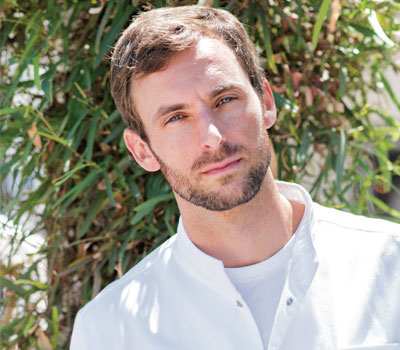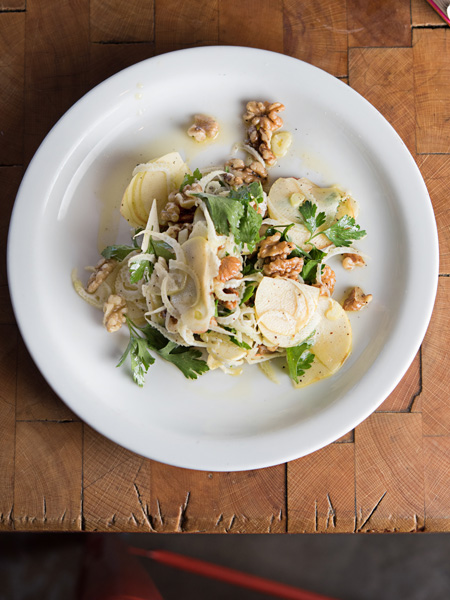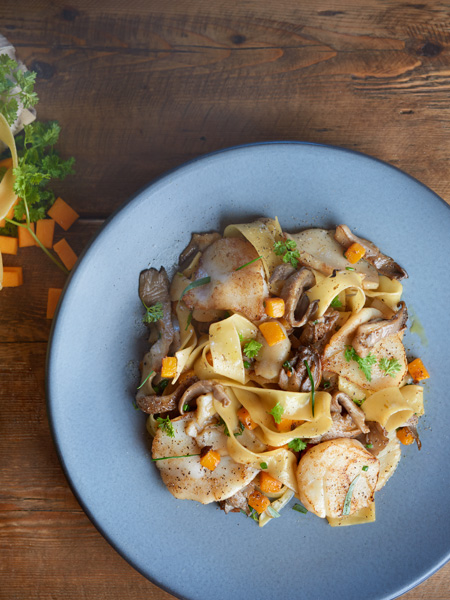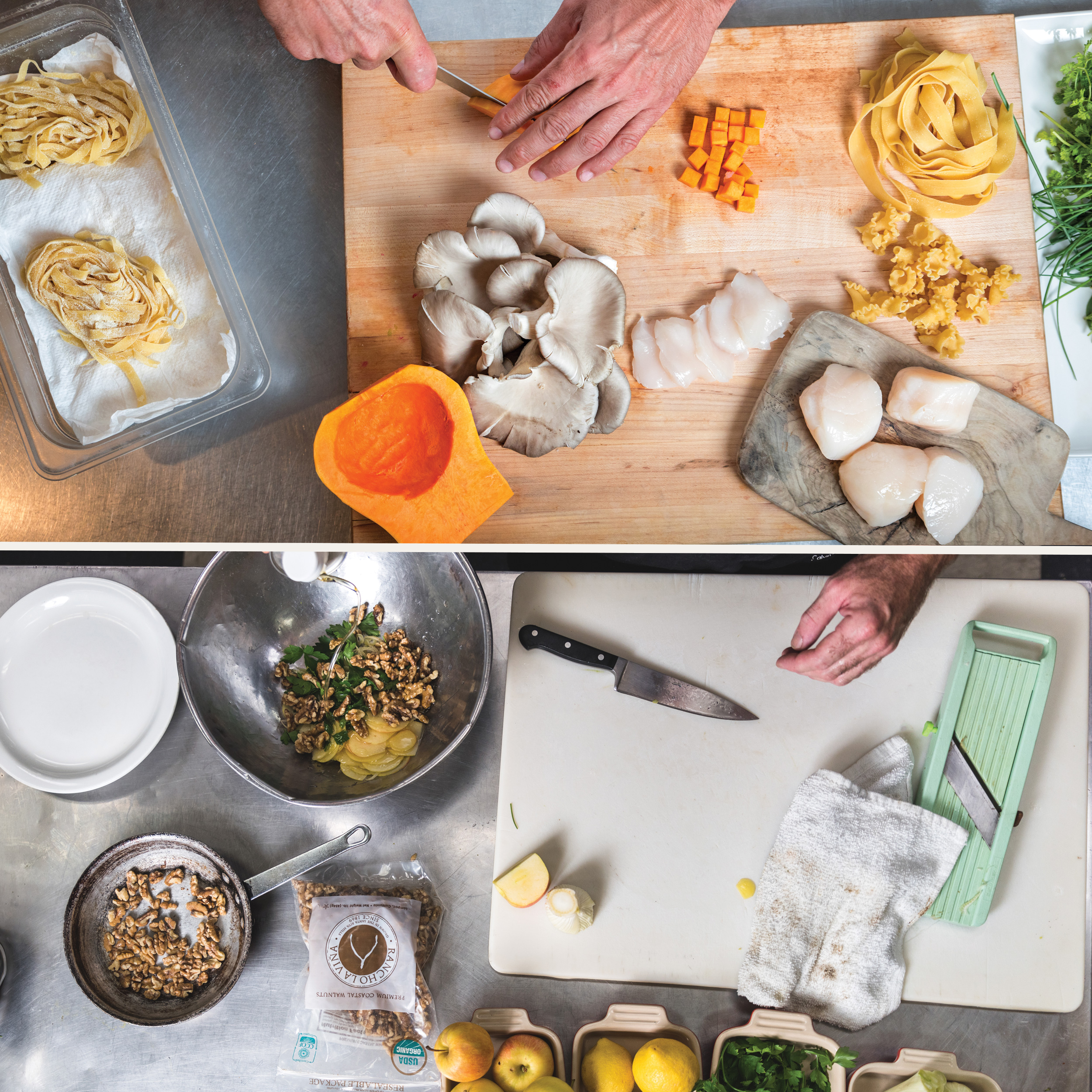Born in Verona, Italy, Luca Crestanelli was living in Los Angeles when he first started to venture up to the Central Coast. He was a private chef at the time, working two-month stints in the Santa Ynez Valley each year. Eventually, in April of 2013, he made the full-time leap to open S.Y. Kitchen. “It was like going home,” he reflects, finding comfort in a landscape reminiscent of the vineyards of Valpolicella so near to his birthplace.
While Crestanelli’s cuisine is deeply Italian-inflected, the focus on clarity and freshness of flavors finds an echo in the best local wines. “You have to be able to enjoy the simplicity of the wine—which is not simple at all,” Crestanelli says. In fact, quiet complexity seems like an apt description for many of the chardonnays growing in the Sta. Rita Hills, fifteen minutes west of Crestanelli’s restaurant in Santa Ynez.
Far removed from the city of Santa Barbara’s tourist glow, Pacific winds created the soft sand dunes that roll toward the Sta. Rita Hills, where even the most barely protected spots are blanketed with vines. Unlike, say, much of Napa Valley, the Sta. Rita Hills remains an agricultural community. Many of the small towns seem sleepy, while inside the restaurants, chefs and sommeliers showcase what’s locally grown.
Crestanelli was drawn here by the ingredients that provide for his farm-to-table cuisine. “Very simple preparations,” he says. “Very understandable combinations and pairings.”
Jeff Olsson is another itinerant chef who settled nearby, in Buellton. Olsson was working at Red Sage in Washington, DC, when he accepted an invitation from Zaca Mesa Winery to cook for their yearly Camp Zaca retreat. “I drove up here and camped in the vineyards, with coyotes howling in the distance,” he recalls. Olsson cooked for five annual retreats before relocating in 2000, when he purchased a local catering company with his wife, Janet.
In December of 2013, Olsson opened his restaurant and butcher shop, Industrial Eats, where he cooks everything in two wood-burning ovens and works with three or four local farms to source his ingredients. “The more equipment you get, the more distracting it can be,” he says.
Housed on a block that includes wineries such as Alma Rosa and Roark, Industrial Eats has a wine list that’s also focused on local producers, with all the options served on tap. I asked Olsson what he might serve with some of the more chiseled styles of Sta. Rita Hills chardonnay, wines of restraint, precision and tension.
He considered going the seafood route, praising how well sea urchins and oysters can complement these wines. But when working with autumn flavors, “things like salads are perfect for more austere, more Chablis-like chardonnays,” Olsson suggested.


The Sta. Rita Hills offers cool-climate chardonnays that seem to readily communicate nuances of place—and that’s not just in the leaner styles.


“You have to be able to enjoy the simplicity of the wine—which is not simple at all.” —Luca Crestanelli
“You could use almost all of those adjectives to describe chardonnay,” he continued. In a single Sta. Rita Hills chardonnay, you can find an earthy concentration, the impression of sweetness, hard spice flavor and an electrifying acidity that beams from the glass and illuminates the salad at hand.
Beyond taste, Olsson finds his apple-and-fennel salad mirrors the weight of these more restrained chardonnays. “It’s a very lean salad. It’s straight lined, not all curvy and round, just like these chardonnays aren’t all curvy and round,” he said. At Industrial Eats, he offers Arcadian’s Clos Pepe Vineyard Chardonnay on tap, suggesting it for the salad.
His salad of apple, fennel, walnut and parsley offers a range of sensations from each ingredient that succeeds in balancing beautifully. “The fresh fennel has an anise flavor to it that is a good counterpart to the sweetness of the apple, the tartness of the lemon juice and the richness of the walnuts,” Olsson said.
Back at S.Y. Kitchen, wine director Bingo Wathen acknowledged that “Fifteen years ago, Sta. Rita Hills wasn’t even on the map.” Now its wines are defined by its position on the coast, the western edge of the Santa Ynez Valley AVA, sandwiched between the towns of Lompoc and Buellton. Running east to west, the rare coastal transverse valley exposes the vines to extreme maritime conditions.
“You have so much coastal influence that it really preserves the varietal distinctiveness,” Wathen said. The ocean finds its way into the soils; much of the Sta. Rita Hills’ southern vineyards are composed of marine shale and pockets of diatomaceous earth, a silica-based soil comprised of fossilized algae. Combined, these influences yield chardonnays of striking character.
Whether from iconic vineyards such as Sanford & Benedict, Clos Pepe and Rita’s Crown, or from newer plantings, the Sta. Rita Hills offers cool-climate chardonnays that seem to readily communicate nuances of place. That’s not just in the leaner styles. The Sta. Rita Hills has one of the longest growing seasons in California, with little fear of rainfall deep into the autumn. So growers can choose to allow Brix levels to rise for weeks after most everyone else in the state has brought in their chardonnay. Picked riper, the chardonnay grapes still maintain their freshness, creating rich wines that can handle more new oak, more frequent bâtonnage and complete malolactic fermentation.
For these fuller-bodied Sta. Rita Hills chardonnays, chef Crestanelli looks to richer local seafood combined with autumn produce, offering his pappardelle with diver scallops, kabocha squash, oyster mushrooms and charred herb-infused olive oil.
“You need something rich to stand up to that type of seafood,” Wathen said of Crestanelli’s diver scallops, pointing to Liquid Farm’s Golden Slope Chardonnay as a counterpoint to the dish. While it’s the most robust Sta. Rita Hills chardonnay in the Liquid Farm portfolio, Golden Slope maintains that same acidic drive Wathen finds characteristic of the appellation.
Regardless of degrees of Brix at harvest or barrel toast levels, Wathen finds a concentration of flavor in Sta. Rita Hills chardonnays that transcends a winemaker’s influence. “You can have rich chardonnays, but they’re driven by this acidity,” he says. “I think that’s what Sta. Rita Hills chardonnay represents. It’s ripe. But it’s balanced.”
Salad of Apple, Fennel, Walnut & Parsley


Ingredients
- 2 apples of your favorite variety
- 2 fennel bulbs
- 1 cup Italian parsley leaves
- 1 cup toasted fresh walnuts*
- 2 Meyer lemons
- really good olive oil
- really good fresh walnut oil*
- salt and pepper
Instructions
- Using the mandolin, shave the apples as thinly as possible into your bowl. Next, the fennel: Holding it by the root end, shave the fennel crosswise into the mixing bowl. Toss in the parsley leaves and walnuts. Slice the lemons in half and squeeze them over the salad. Add a splash each of olive oil and walnut oil. Toss well and season with salt and pepper to taste.
Notes
Pappardelle with Diver Scallops, Kabocha Squash & Oyster Mushrooms


Ingredients
Serves four.
- 1/2 small kabocha squash, peeled and seeded
- 3 to 4 cloves garlic
- 1/2 pound oyster mushrooms, cleaned, trimmed and sliced
- Diver scallops (preferably U10 or U8,1 to 2 per person)
- 1 pound fresh pappardelle
- Sea salt & fresh-ground pepper to taste
- 3 tbsp olive oil
- 1/2 shallot, peeled and chopped
- 1/4 tsp red chile flakes
- 1/4 cup white wine or dry vermouth
- 1/2 cup vegetable stock
- 2 tbsp butter
- 2 tbsp charred-herb-infused olive oil (recipe follows)
- 1 tsp fresh chervil sprigs
- 1 tsp chopped fresh tarragon
- 1/2 tsp chopped fresh chives
Instructions
- Preheat oven to 350˚F.
- Dice the squash and place it in a large bowl. Smash one clove of garlic with the side of a chef’s knife, and add to bowl. Sprinkle with olive oil, season with salt and pepper, and spread evenly on a sheet pan. Place in oven and cook for 10 minutes. Remove from oven, discard garlic, and reserve the squash.
- Heat a large sauté pan over medium heat. Add 2 tablespoons of olive oil (and a chopped clove of garlic, if desired). Add the mushrooms and sauté until just cooked. Season with salt and pepper and reserve.
- Cut scallops horizontally into 4 to 5 thin slices. Set aside.
- Just before serving, fill a large pot with water and salt liberally with sea salt. Bring it to a boil over high heat and add the pasta. Cook until al dente and drain.
- While the pasta is cooking, mince the remaining clove of garlic. Heat a large nonstick sauté pan over medium-high heat and add olive oil, minced garlic, shallot and chile flakes. Sauté until fragrant and soft. Add squash and sauté until heated through. Add the scallops, white wine or vermouth, vegetable stock and butter and mix well, cooking until heated through.
- Add the cooked pasta to the sauté pan and toss to coat. Drizzle the charred-herb oil over top and serve, garnishing each bowl with the fresh herbs.
Charred-Herb-Infused Olive Oil
- Prepare charred-herb-infused olive oil three days in advance: Dry stems of tarragon and chervil, as well as some chives, for two days. Place on a sheet pan lined with aluminum foil and light them with a match. Let them burn until charred. Place the charred herbs in a stainless-steel pot; add a clove of unpeeled garlic and add enough olive oil to cover. Cover the pot and let oil infuse overnight. The next day, strain the oil and keep it in a tightly sealed bottle.
The 2015 recipient of Vinous Media’s Young Wine Writer Fellowship has been enthusiastically exploring California’s wine regions since he moved to San Francisco after Yale. When he isn’t writing or visiting vineyards, he’s likely singing opera or in search of his next taco.
This story appears in the print issue
of October 2017.
Like what you read? Subscribe
today.
















